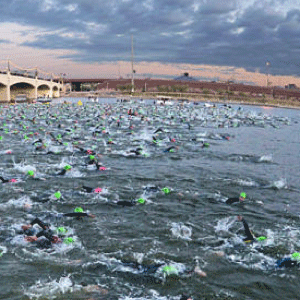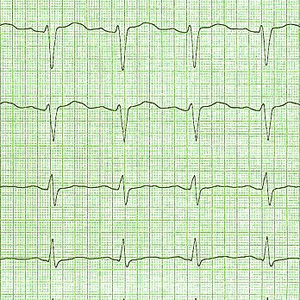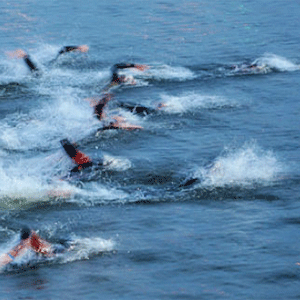Can RD’s Impact SCD in Tri?

Twice over the last days I’ve written to athletes concerned by the spate of swim deaths in triathlon. Some think that our rate of drownings is unfairly sensationalized because of the growth of triathlon and the growth in our media’s ability to broadcast the news of a death.
In USAT’s report on deaths in our sport we’re told we’re in the same neighborhood as those who run marathons: 1 out of 75,000 or so race occurrences, and we’re better off than in NCAA sports, where the rate is more like 1 in 45,000. That’s not exactly true. We’re not counting deaths in practice, as the NCAA does. Still, let us stipulate that our rate does not seem entirely out of whack. We have this maddening truth: we seem capable of surviving the bike and run. We might produce stellar survival numbers if it were just those two events. But there is something about the swim.
In this segment I’m going to talk about what race directors can do. I’m not going to focus on the things that you might think. I’m not going to write about the deployment of lifeguards. I’ve written about that in the past. I’m not going to talk about watercraft, and their deployment, though I think we need to have a come-to-Jesus about what a proper time frame is between identifying a still body in the water and the time a defibrillator is applied to that still body. I do not think we, as a sport, have thought through how it is we get a body onto a boat, or a jet ski, or a paddleboard. I say this because I have heard anecdotally about the difficulties in doing so. It’s great if there is a lifeguard or Coast Guard boat at the race, but if a swimmer is unconscious amongst other swimmers who are conscious, how does the boat get to the swimmer in need while not injuring the others? Is there a certain strategy for getting that limp swimmer’s body into the boat? Or onto a jet ski?
By not addressing these points above, I don’t want to sidestep their importance, or minimize it. I want to maximize it. I just feel this this is a project I want to do with USA Triathlon, and Triathlon Business International, our sport’s industry group. If I’m going to tell the U.S. Coast Guard, or a city, county or state lifeguard department, how to do its business, I want these other organizations to know exactly what I’m going to say, and I think we need to say it together.
Today I just want to talk about course set up and athlete communication. Stuff that is largely in the purview of the race director along with, perhaps, USA Triathlon.
The one thing that I think does require a rule change is stopping in the water. We need to “unstigmatize” that. We need to encourage our athletes to stop. Right now. Stop. If you think you might be in a spot of trouble. We need to encourage our athletes to seek out and engage with a lifeguard or EMT if that’s what seems necessary. Hang onto the paddleboard if you need to. Wait. catch your breath. Then proceed. Athletes should feel free to do this without any fear that they will be disqualified or pulled from the race. There is no other part of our race where stopping and consulting with any sort of official triggers a DNF or a DQ. If I swim over and stop at a paddleboard, and rest while holding myself on it, are you afraid of the unfair advantage I’m taking, as you swim away from me and toward T1?
Now, I know some of you RDs are uncomfortable with having to do this, especially because some of your races will not easily allow for it in their current configurations, but the excuses why you do not allow a warm up are quickly wearing thin. The evidence seems to me to point toward a logical conclusion: that some, many, or most athletes who die in the swim are overcome by a cascade of bad luck and bad occurrences, among them hypoxia combined with a strident shock or storm of adrenalin. The swim starts fast. Too fast for most. Our athletes are very willing to commence the swim at a pace and a rate they’d never consider for a footrace. To that end, RDs need, in my view, to do two things: First, if the athletes are going to start at that pace, they need to be adequately warmed up. If you want them to go very hypoxic very quickly, send them off at that pace with no warm up.

Second, it might be prudent to warn them about starting off too fast. Decades ago I approached a USAT official and said, “Why don’t you spend 2 of the 5 minutes between each wave explaining to these people what the very basic rules of the road are? You have their attention. They are forced to listen to you. Why not use that time wisely?” He explained to me that his job was to officiate, not to educate. Thankfully, our national governing body has come a long way since those days, and we often hear the basic rules, like, “ride to the right, pass on the left” given to swimmers just before blast-off. Can we add to this a simple exhortation: “Few of you are in danger of starting out too slow. Many are in danger of starting out too fast. At a minimum, this is bad pacing. At the maximum, it can get you into much worse trouble. It’s a long day. Start out comfortably. Stay relaxed. You’ll probably finish faster if you do, but what’s much more important… you’ll finish.”
Your warm up area should be utilized. You should have a lifeguard there. You move each wave from the beach, to the warm up area, and then to a staging area just prior to the start corral, then to the start corral. If you put a race on in a river, where the flow of the water makes warm ups not possible, I don’t know what to tell you. I will only note that in recent races, over the last couple of years, where the warm up is precluded, there seems to me to be a higher than normal incidence of deaths in the water. I don’t think the lack of a warm up caused anyone to die, just, as I said previously, my gut tells me that these deaths are caused by a cascade of bad fortune. I don’t know if someone dead today would be alive today if that person had available himself of a warm up. But I think deaths in 10ks would be higher if these folks started out in a dead sprint, with no warm up, and only allowed one breath for three strides.
Which is my lead-in to something I think you should remember. Breathing is metered in the swim. Unlike any other sport, you are only able to take a breath once per increment of work you do. This is why people start off so quickly in the swim. The work they’re doing does not feel hard, because, muscularly, it isn’t hard. But you’re not in oxygen debt yet. Wait a couple of hundred yards and that fast early pace will catch up to you, because you are only allowed to take in X amount of oxygen per work expended. This is why I encourage swimmers to practice breathing techniques that cheat that cadence. I mention this to you race directors because there are reasons why people tend to start out too quickly in your swims, and why that causes them to sometimes get into some difficulty later on into the swim.

Understand that buoys that represent a turn are natural congregating places. People bunch up there. It’s like shooting the gun for the New York Marathon, but, 1 mile in you make everyone run through a set of subway turnstiles. Turn buoys are scenes of havoc. It is therefore ill advised to place these turn buoys too close to the start. If your swim has to make a turn and travel at an angle away from the beach, rather than straight out from shore, best not to have a beach start followed by a buoy 40 yards offshore. Better to let your folks wade into the water, and commence with a deep water start already angled in the direction you need them to go.
The other crowding issue is at the start. There is no reason why starts cannot be sufficiently wide in venues that will allow for it.
Finally, I think we miss an opportunity when we don’t start to talking to our athletes weeks and months out. Not everyone who participates in a triathlon will read Slowtwitch prior to their races this season. Not by a longshot. What will they read? What can they read? You have their email addresses, because these folks registered online for your races. They’ll read whatever you send them. We have committed, here on Slowtwitch, to write a series of articles that you may use at your discretion, no charge, and these will be how-to articles that will prepare your athletes better for the swim than they might otherwise have been. Your race, in its formation, is not a one-day execution. It starts out many months in advance. Likewise the preparation by the athletes who race in it. Your communication to them should not be only during race week, and only about registration and parking. It should be a weeks-long process. Let us use that time wisely, so that your athletes enter the water well equipped.
[Images by the maestro, Timothy G. Carlson]




Start the discussion at slowtwitch.northend.network